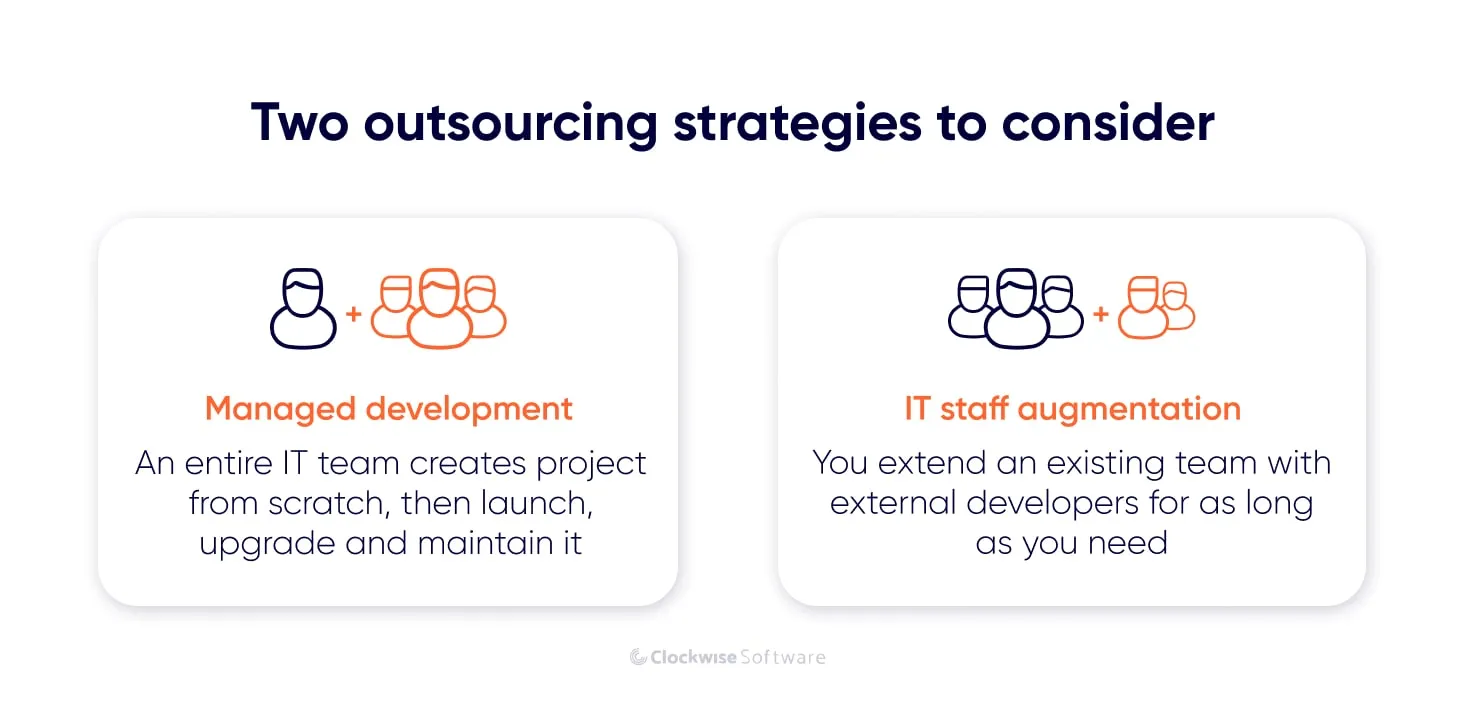What we do
Services
Experts in
The pandemic-caused crisis not only generated unpredictable challenges for businesses worldwide but showed that office-based work has lost its purpose in certain professions. Millions of specialists easily switched to remote-only employment without harming their performance or dedication.
For particular professions, the remote approach has actually improved performance and productivity considerably. For example, a study by Stanford discovered productivity increased by 13% since working from home became a COVID-forced practice.
IT and software engineering companies practiced remote work long before it became a necessity. But now, everyone hires remotely. After a temporary shortage in openings, the job market is active as never before.
And hiring has turned into a headache.
Fortunately, when you can hire remotely, there’s no need to consider candidates strictly from your region. You can find top talents with deep experience in other countries for a lower price.
Software outsourcing and outstaffing model allows you to hire specialists overseas while optimizing costs and efforts. There are two main types of outstaffing: staff augmentation, when you strengthen your existing development team with remote specialists, and managed software development, when you hire an entire team at once to create a software product for your business from scratch.

In this article, you’ll find out about Dedicated development team vs managed services, discover their differences, and learn about reasons to choose a particular strategy for your project.
A managed software development team is a whole team of IT professionals who work on your project from the very beginning through its successful launch, further upgrades, and maintenance. The team includes all necessary roles, which are typically the following:
The team size and composition fully depends on your product vision and needs.
According to the managed team model, the development team takes complete responsibility for controlling the development time, scope of work, and project budget.
A dedicated project manager leads the team and ensures you achieve key development results. The project manager takes part in creating extensive project documentation, planning project milestones, and setting up effective communication and interactions among team members. This is the person you can fully delegate management-related tasks to. Meanwhile, you can prioritize business development and invest your time in processes and decisions that require your full attention.
A managed team takes responsibility for delivering chosen features and the entire project on time and according to quality standards. This approach is often implemented through a dedicated development center, where your partner assembles a team tailored specifically to your project needs and manages all operational aspects from staffing to delivery.
You can get a managed development team with either a fixed price or a time and materials payment model.
Dedicated development team, or the IT outstaffing model, allows you to extend an existing team with external developers who will work with you as long as you need. In this case, a web development company plays the role of an intermediary, providing engineers with all the necessary tools, devices, and infrastructure, while you pay a flat monthly fee for their work. The outsourcing company handles all legal and HR procedures.
You can either hire an entire engineering team or hire new specialists to join an existing team.
When hiring external developers, you are fully responsible for your project. No matter how many engineers you add to your team, they will just follow the product roadmap while you and the core team make technical and business decisions. Even if you hire project managers to join an existing team, you will still need to take an active part in project planning, join discussions, and make decisions yourself.
This option is typically an alternative to in-house hiring. With staff augmentation, an employer can cut recruitment and payroll costs, save on infrastructure, and minimize participation in HR procedures.
Let’s dive deeper and find out the key differences between Dedicated development team and managed services:
When you opt for the software outsourcing model, your service provider is fully responsible for recruitment and employment. You don’t need to invest months in on-site recruiting and hiring, and you don’t need to invest in HR services.
In this case, the outsourcing company provides CVs of relevant candidates who are ready to join your development team and start working on your tasks as soon as possible.
With the managed services approach, you don’t actually hire developers. You pay for the scope of work to be done or the project to be built. Your vendor provides you with all specialists required for the process, including engineers, designers, managers, and analysts.
Still, you can participate in selecting and interviewing candidates.
Onboarding is the set of actions to introduce new employees to a team and guide them through your product, objectives, and tasks. This is an essential activity if you have an ongoing development process.
Typically, the onboarding process should last no longer than several weeks.
When hiring new specialists to an existing team with the staff augmentation model, you and your team may want to develop and organize an onboarding plan.
With the managed services approach, your software development partner takes full responsibility for successful onboarding. They decide how to compose the team and when to extend it with new talents to optimize development and deliver functionality according to the planned schedule.
When comparing staff augmentation with a managed team, there’s a significant question you should answer: What amount of responsibility are you ready to delegate?
Would you like your team to handle all engineering tasks while you work on product promotion and business development?
Or would you like to take an active part in app development, meetings, and discussions as well as maintain communication with all team members?
If you don’t mind being deeply involved in the development process, staff augmentation may better serve your needs. With staff augmentation, you and your internal team take all responsibility for project development, feature prioritization, and critical engineering decisions.
If you would like to delegate technical tasks and decisions and fully focus on your business growth, you probably need to start cooperating with a fully managed team. A dedicated project manager working on your team can take care of communication and operational tasks while providing you with progress reports.
Even if you would like to minimize your participation, the role of product owner is critical. Effective development requires your input. The more time and attention you invest in discussions and documentation development during the project discovery phase, the better the project will meet your requirements and expectations.
How many specialists should you hire? It’s up to you to decide.
In the case of Dedicated development team, you can hire as many specialists as you need. You can hire individuals to complete a defined scope of work and only pay for their development hours.
Team size and composition depend on multiple factors such as your needs and expectations, project requirements, budget, and deadline. A software development partner will analyze their previous experience and similar projects to provide you with a team that’s able to deal with your tasks quickly and effectively.
All you need to do is describe your expectations in detail to your project discovery and development team. With well-written documentation, your development partner will handle all the rest.
There are numerous factors that may impact the cost of project development. You can get a definite estimate only after the project discovery phase.

Before that, find out what you’re going to pay for.
When augmenting your team with external developers, you pay for the time they spend on your tasks.
With a managed development team, you pay for the scope of work specialists complete.
The costs for software development services differ widely. You can find out more about prices and specifics in our article on the pros and cons of outsourcing software development.
The time and materials and monthly flat fee payment models are the most common for software development services. However, when you hire a managed team to build an MVP from scratch, you and your development partner may also agree on a fixed price model.
Let’s sum up these six points.
|
Managed services |
Dedicated development team |
|
|
HR procedures |
Covered by development partner |
Covered by development partner |
|
Onboarding |
Organized by development partner |
Organized by your team |
|
Level of responsibility |
Development partner takes full responsibility for project deliverables |
You and your core team are responsible for deliverables |
|
Team size and structure |
Development partner suggests the best team size and composition according to your project needs |
You hire as many specialists as you need for the roles your project requires *One team member or more |
|
Cost |
Development partner provides you with definitive time and cost estimates |
Monthly flat fee depends on the number of developers you hire, their skills, and their seniority |
|
Payment model |
Fixed price for defined deliverables or time and materials model |
Flat monthly fee |
Hiring a managed team may be the best option if you:
Choose the Dedicated development team model if you:
